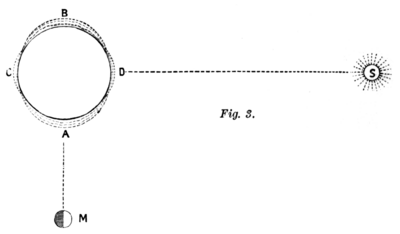of a very high or spring-tide, as in fig. 2, where the tide at a and b has risen extremely high, while at c and d it has fallen correspondingly low. When

they act in opposition to each other, as at the moon’s quarter, there occurs a very low or neap-tide. In fig. 3 the moon has raised high tide at a and b, but the sun has counteracted its influence to some extent at c and d, thus producing neap-tides, which

neither rise so high nor fall so low as do other tides. Tides attain various elevations in different parts of the world, partly owing to local influences. In the Bristol Channel the tide rises to nearly sixty feet, while in the Mediterranean it is extremely small, owing to the land-locked nature of that sea preventing the tidal wave from having its full effect. Up some gulfs and estuaries the tides sweep with the violence of a
